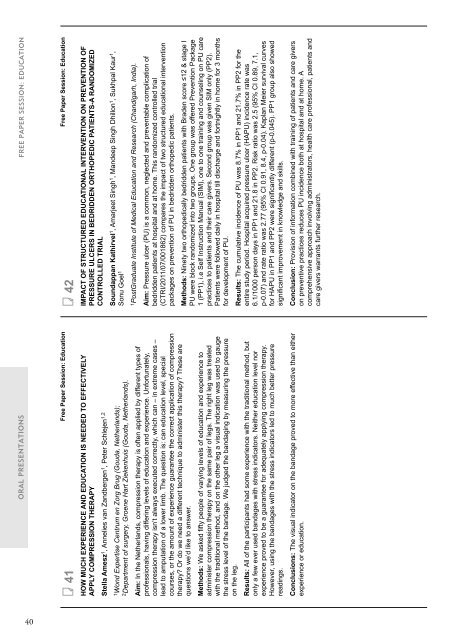You also want an ePaper? Increase the reach of your titles
YUMPU automatically turns print PDFs into web optimized ePapers that Google loves.
ORAL PRESENTATIONS<br />
41<br />
Free Paper Session: Education<br />
HOW MUCH EXPERIENCE AND EDUCATION IS NEEDED TO EFFECTIVELY<br />
APPLY COMPRESSION THERAPY<br />
Stella Amesz 1 , Annelies van Zandbergen 1 , Peter Schlejen 1,2<br />
1 Wond Expertise Centrum en Zorg Brug (Gouda, Netherlands);<br />
2 Department of surgery, Groene Hart Ziekenhuis (Gouda, Netherlands).<br />
Aim: In the Netherlands, compression therapy is often applied by different types of<br />
professionals, having differing levels of education and experience. Unfortunately,<br />
compression therapy isn’t always executed correctly, which can – in extreme cases –<br />
lead to amputation of a lower limb. The question is: can education level, special<br />
courses, or the amount of experience guarantee the correct application of compression<br />
therapy? Or do we need a different technique to administer this therapy? These are<br />
questions we’d like to answer.<br />
Methods: We asked fifty people of varying levels of education and experience to<br />
administer compression therapy on the same pair of legs. The right leg was treated<br />
with the traditional method, and on the other leg a visual indication was used to gauge<br />
the stress level of the bandage. We judged the bandaging by measuring the pressure<br />
on the leg.<br />
Results: All of the participants had some experience with the traditional method, but<br />
only a few ever used bandages with stress indicators. Neither education level nor<br />
experience proved to be a guarantee for adequately applying compression therapy.<br />
However, using the bandages with the stress indicators led to much better pressure<br />
readings.<br />
Conclusions: The visual indicator on the bandage proved to more effective than either<br />
experience or education.<br />
FREE PAPER SESSION: EDUCATION<br />
42<br />
Free Paper Session: Education<br />
IMPACT OF STRUCTURED EDUCATIONAL INTERVENTION ON PREVENTION OF<br />
PRESSURE ULCERS IN BEDRIDDEN ORTHOPEDIC PATIENTS-A RANDOMIZED<br />
CONTROLLED TRIAL<br />
Soundappan Kathirvel 1 , Amarjeet Singh 1 , Mandeep Singh Dhillon 1 , Sukhpal Kaur 1 ,<br />
Sonu Goel 1<br />
1 PostGraduate Institute of Medical Education and Research (Chandigarh, India).<br />
Aim: Pressure ulcer (PU) is a common, neglected and preventable complication of<br />
bedridden patients at hospital and at home. This randomized controlled trial<br />
(CTRI/2011/07/001862) compares the impact of two structured educational intervention<br />
packages on prevention of PU in bedridden orthopedic patients.<br />
Methods: Ninety two orthopedically bedridden patients with Braden score ≤12 & stage I<br />
PU were block randomized into two groups. One group was offered Prevention Package<br />
1 (PP1), i.e Self Instruction Manual (SIM), one to one training and counseling on PU care<br />
practices to patients and their care givers. Second group was given SIM only (PP2).<br />
Patients were followed daily in hospital till discharge and fortnightly in home for 3 months<br />
for development of PU.<br />
Results: The cumulative incidence of PU was 8.7% in PP1 and 21.7% in PP2 for the<br />
entire study period. Hospital acquired pressure ulcer (HAPU) incidence rate was<br />
6.1/1000 person days in PP1 and 21.8 in PP2. Risk ratio was 2.5 (95% CI 0.89, 7.1,<br />
p-0.07) and rate ratio was 2.77 (95% CI 0.91, 8.4, p-0.04). Kaplan Meier survival curves<br />
for HAPU in PP1 and PP2 were significantly different (p-0.045). PP1 group also showed<br />
significant improvement in knowledge and skills.<br />
Conclusion: Provision of information combined with training of patients and care givers<br />
on preventive practices reduces PU incidence both at hospital and at home. A<br />
comprehensive approach involving administrators, health care professional, patients and<br />
care givers warrants further research.<br />
40






